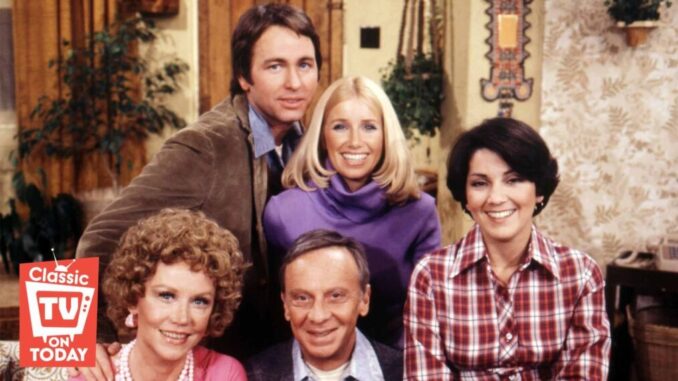
Some TV shows fade into history, while others stand the test of time. Three’s Company is undoubtedly in the latter category. The hit 70s sitcom, known for its hilarious misunderstandings and slapstick humor, continues to have a devoted fanbase decades later. But what’s the secret to its lasting appeal?
One of the show’s stars recently revealed that Three’s Company wasn’t just a sitcom—it was a safe haven during tough and “oppressive” times. But what made it so special? And why do people still love it today? Let’s dive in.
The Legacy of ‘Three’s Company’
A Show That Defined an Era
Premiering in 1977, Three’s Company quickly became one of the most popular sitcoms of its time. It followed the comedic misadventures of three roommates—Jack, Janet, and Chrissy—living in Santa Monica.
But beyond the laughs, the show subtly addressed changing social norms, relationships, and gender dynamics, making it a product of its time and yet timeless in its humor.
Why Fans Still Love It Today
Despite ending in 1984, Three’s Company continues to attract new fans. Why? The humor is universal, the characters are relatable, and the nostalgia factor is strong.
But there’s another reason: for many, the show provided a sense of escape, especially during challenging times.
A ‘Safe Haven’ During Oppressive Times
A Laughter-Filled Escape from Reality
One of the show’s stars recently stated that Three’s Company became a refuge for many viewers. During difficult political and economic times, people turned to the sitcom for relief.
Just like today, the late 70s and early 80s had their fair share of struggles. The economy was unstable, social movements were shifting, and global tensions were rising. But for 30 minutes, audiences could forget their worries and simply laugh.
Breaking Taboos with Humor
While it was a lighthearted sitcom, Three’s Company pushed boundaries. The premise—one man pretending to be gay to live with two women—was controversial at the time. Yet, it handled the subject with humor and charm, making complex social issues more digestible for audiences.
An Inclusive and Progressive Approach
Even though it may not seem radical by today’s standards, the show subtly challenged traditional norms. It portrayed friendships between men and women in a way that wasn’t always common on TV. It also showed independent women navigating their careers and relationships on their own terms.
The Show’s Timeless Humor and Cultural Impact
Physical Comedy at Its Best
Few shows mastered physical comedy like Three’s Company. John Ritter’s impeccable timing and slapstick genius set the bar high. Whether it was tripping over furniture or pulling off elaborate misunderstandings, the comedy was universally appealing.
Memorable Characters That Still Resonate
Each character brought something unique to the table:
- Jack Tripper (John Ritter) – The charming yet clumsy chef.
- Janet Wood (Joyce DeWitt) – The intelligent and responsible one.
- Chrissy Snow (Suzanne Somers) – The lovable and bubbly blonde.
Their chemistry made the show work, and fans still connect with their personalities today.
Rewatchability Factor: The Key to Lifelong Fans
Unlike some shows that feel dated, Three’s Company remains easy to rewatch. The humor is simple yet effective, and the storylines don’t rely on technology or trends that might feel outdated.
Why Nostalgia Plays a Huge Role in Its Popularity
Comfort TV in a Changing World
People often turn to shows from their past for comfort. Three’s Company represents a simpler time for many fans. Whether they watched it as kids with their families or discovered it later, the nostalgia factor is powerful.
Streaming Keeps It Alive
With classic TV more accessible than ever, new generations are discovering Three’s Company. Streaming services have breathed new life into old sitcoms, and audiences who weren’t even born when it aired are now enjoying its humor.
The Importance of Sitcoms as Escapism
Laughter is Therapy
In stressful times, sitcoms like Three’s Company provide much-needed laughter. Studies show that comedy can reduce stress and improve mood, which explains why people return to shows that make them laugh.
A Feel-Good Formula That Works
The simple yet effective sitcom formula—funny misunderstandings, lovable characters, and heartwarming moments—creates a sense of familiarity and comfort that keeps audiences coming back.
Conclusion
Three’s Company isn’t just a sitcom; it’s a cultural time capsule that continues to bring joy. It provided laughter during tough times and remains a safe haven for fans today.
Whether it’s the timeless humor, unforgettable characters, or nostalgic charm, this classic show proves that great TV never truly fades. And as long as people need a good laugh, Three’s Company will always have a place in their hearts.
FAQs
1. Why was ‘Three’s Company’ so popular?
It combined hilarious physical comedy, strong character dynamics, and a feel-good atmosphere that resonated with audiences.
2. Is ‘Three’s Company’ still popular today?
Yes! Thanks to streaming platforms and syndication, new generations continue to discover and love the show.
3. Did ‘Three’s Company’ address any serious social issues?
While primarily a comedy, the show subtly challenged gender norms and societal expectations in a lighthearted way.
4. What made John Ritter’s performance so special?
His incredible comedic timing, physical comedy skills, and charismatic presence made Jack Tripper one of the most beloved sitcom characters ever.
5. Why do people consider ‘Three’s Company’ a ‘safe haven’?
It provided much-needed laughter and escapism during difficult times, making it a comforting show for many fans.
